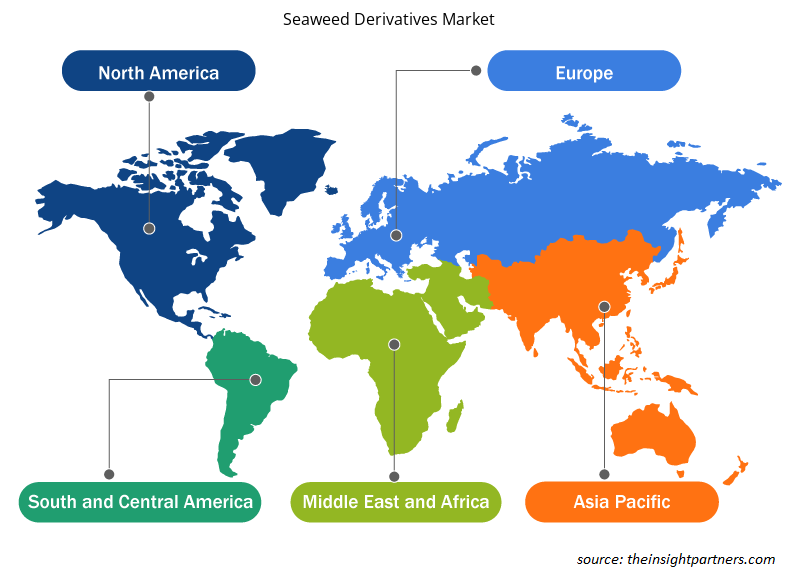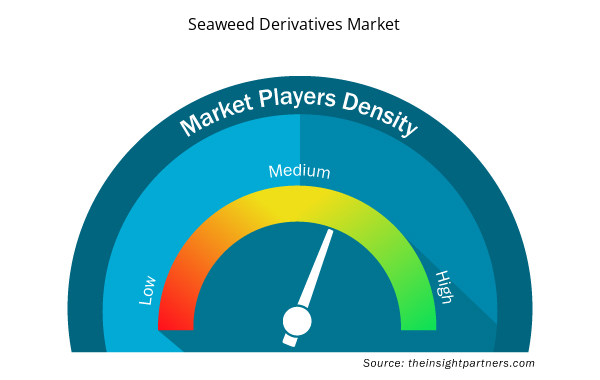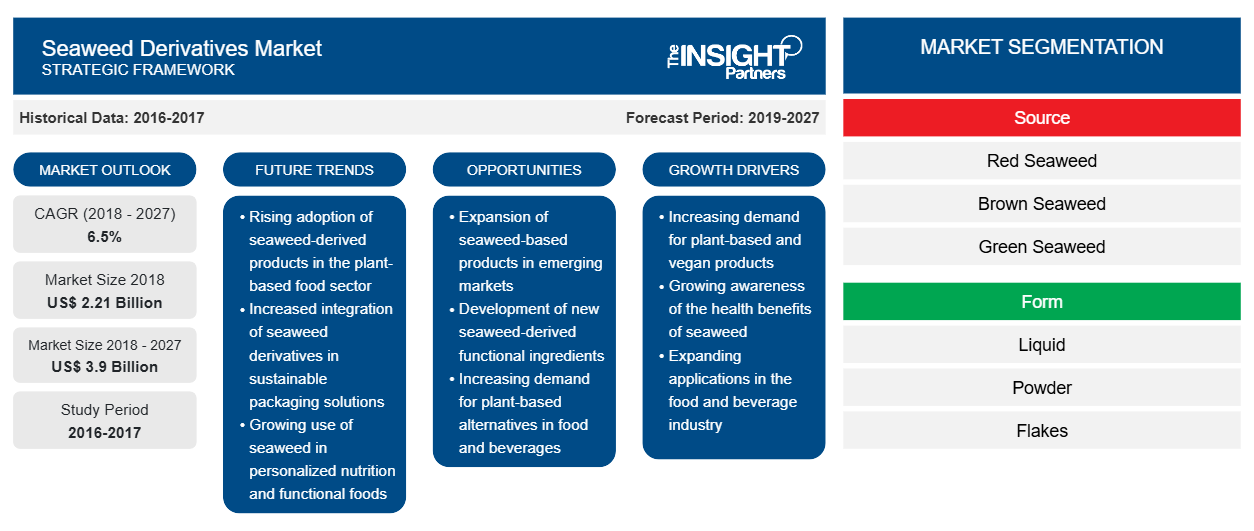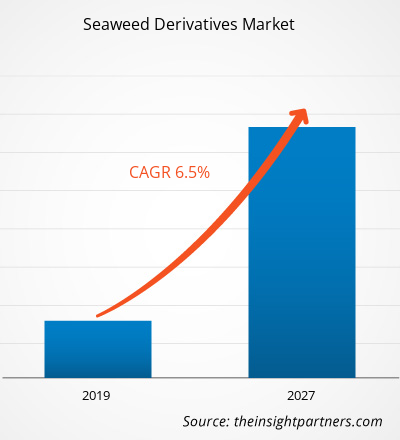El mercado de derivados de algas fue valorado en US$ 2.210,35 millones en 2018 y se proyecta que alcance los US$ 3.903,91 millones en 2027; se espera que crezca a una CAGR de 6,5% de 2019 a 2027.
Las algas marinas son básicamente microalgas marinas rojas, marrones y verdes, cuyos extractos se utilizan en los cultivos hortícolas por sus efectos promotores del crecimiento de las plantas. Los derivados químicos de las algas marinas incluyen ácidos grasos y vitaminas, nutrientes minerales, fitoarmonas y polisacáridos complejos, entre otros. Los principales derivados de las algas marinas incluyen alginatos, carragenanos y agares. Los alginatos se extraen en gran medida de las algas pardas, mientras que los carragenanos y agares se extraen en gran medida de las algas rojas. Los alginatos, carragenanos y agares se utilizan cada vez más en la industria de alimentos y bebidas, alimentos para animales y agricultura, entre otros.
En 2018, Asia Pacífico tuvo la mayor participación en el mercado mundial de derivados de algas marinas , seguida de Europa y América del Norte. La creciente demanda de alimentos y bebidas, alimentos para animales y la industria agrícola está impulsando principalmente el mercado en la región de Asia Pacífico. China, Corea del Sur y Japón son los principales productores y consumidores de derivados de algas marinas en la región de Asia Pacífico. El mercado está impulsado principalmente por la aplicación más amplia de derivados de algas marinas en la industria de alimentos y bebidas. Se utiliza cada vez más en fertilizantes, lo que mejora el rendimiento de los cultivos y aumenta la fuerza de los cultivos, lo que ayuda a la resistencia a las plagas. La creciente conciencia de los consumidores sobre los beneficios para la salud de los derivados de las algas marinas está impulsando considerablemente el mercado de las algas marinas. Además, la creciente demanda de productos alimenticios orgánicos impulsa el crecimiento del mercado de derivados de algas marinas. La menor conciencia entre los agricultores sobre la extracción de algas marinas está resistiendo el crecimiento del mercado de derivados de algas marinas.
El brote de COVID-19 comenzó en Wuhan (China) en diciembre de 2019 y, desde entonces, se ha extendido por todo el mundo a un ritmo rápido. China, Italia, Irán, España, la República de Corea, Francia, Alemania y los EE. UU. se encuentran entre los países más afectados en términos de casos positivos y muertes reportadas a marzo de 2020. El brote de COVID-19 ha afectado a las economías e industrias en varios países debido a los cierres, las prohibiciones de viaje y los cierres de negocios. La industria mundial de alimentos y bebidas es una de las principales industrias que sufre graves interrupciones, como interrupciones de la cadena de suministro, cancelaciones de eventos tecnológicos y cierres de oficinas como resultado de este brote. Por ejemplo, China es el centro mundial de fabricación y el mayor proveedor de materias primas para varias industrias. El colapso general del mercado debido a COVID-19 también está afectando el crecimiento del mercado de derivados de algas debido al cierre de fábricas, obstáculos en la cadena de suministro y recesión en la economía mundial.
Personalice este informe según sus necesidades
Obtendrá personalización en cualquier informe, sin cargo, incluidas partes de este informe o análisis a nivel de país, paquete de datos de Excel, así como también grandes ofertas y descuentos para empresas emergentes y universidades.
- Obtenga las principales tendencias clave del mercado de este informe.Esta muestra GRATUITA incluirá análisis de datos, desde tendencias del mercado hasta estimaciones y pronósticos.
Perspectivas del mercado
La creciente demanda de la industria de alimentos y bebidas ha favorecido el mercado de derivados de algas a nivel mundial.
Los derivados de algas marinas, como los agares, los alginatos y los carragenanos, se utilizan ampliamente en diversos productos alimenticios y bebidas. Estos derivados se utilizan en una amplia gama de alimentos y bebidas, como helados, jarabes, fiambres, fórmulas para bebés, leche de almendras, crema batida, barras de chocolate, leche con chocolate, bebidas de café (por ejemplo, café helado y bebidas de café a base de soja), crema para café, requesón, yogur, requesón y crema agria, entre otros. Los carragenanos se utilizan como ingrediente espesante en pudines, leche con chocolate, chicles, mermeladas y jaleas. Además, los carragenanos reducen el desperdicio al extender la vida útil de los alimentos sin ninguna pérdida de calidad. Varios alimentos, como la mayonesa y el aderezo para ensaladas, se separarían sin la ayuda de un estabilizador. Por lo tanto, el carragenano se utiliza como agente estabilizador en la mayonesa y el aderezo para ensaladas. Por lo tanto, una amplia gama de aplicaciones de los derivados de algas en la industria de alimentos y bebidas impulsa el crecimiento del mercado de derivados de algas a nivel mundial.
Información de origen
Según las fuentes, el mercado de derivados de algas se segmenta en algas rojas, algas pardas y algas verdes. En 2018, el segmento de algas rojas representó la mayor participación del mercado mundial de derivados de algas. Las algas rojas tienden a poseer los niveles más altos de proteína, que son responsables de su color rojo. A pesar de encontrarse en aguas poco profundas, las algas rojas son capaces de soportar aguas profundas y condiciones de poca luz. Estos factores impulsan el crecimiento del mercado de derivados de algas rojas.
Información sobre formularios
Según la forma, el mercado de derivados de algas marinas se segmenta en líquido, polvo y copos. En 2018, el segmento líquido representó la mayor participación del mercado mundial de derivados de algas marinas; sin embargo, se espera que el segmento en polvo registre la tasa de crecimiento más rápida durante el período de pronóstico. Los derivados líquidos de las algas pardas se comercializan para su uso en horticultura y agricultura. Los derivados líquidos de las algas marinas se utilizan en altas tasas de dilución, lo que da como resultado que se apliquen cantidades mínimas de material en el área determinada. Las sustancias activas en los derivados líquidos de las algas marinas son capaces de afectar a temperaturas tan bajas.
Información sobre el uso final
Según el uso final, el mercado de derivados de algas marinas se segmenta en alimentos y bebidas, productos agrícolas, aditivos para piensos animales, productos farmacéuticos y otros. En 2018, el segmento de alimentos y bebidas representó la mayor parte del mercado mundial de derivados de algas marinas; sin embargo, se espera que el segmento de aditivos para piensos animales registre la tasa de crecimiento más rápida durante el período de pronóstico. Los derivados de algas marinas, como los alginatos, se utilizan ampliamente en productos de panadería, dulces, productos lácteos, aderezos para ensaladas, helados, cremas y gelatinas, así como en embutidos, procesamiento de carnes y pescado. También se utiliza para clarificar cervezas y vinos. Los alginatos son completamente orgánicos y son una sustancia segura para su aplicación en alimentos. Además, los alginatos son capaces de espesar una solución cuando se disuelven en agua. Además, los alginatos pueden formar geles cuando se añaden a una solución de sal de calcio. Por lo tanto, los alginatos se utilizan principalmente en aderezos para ensaladas y mayonesa.
Perspectivas regionales del mercado de derivados de algas
Los analistas de Insight Partners han explicado detalladamente las tendencias y los factores regionales que influyen en el mercado de derivados de algas marinas durante el período de pronóstico. Esta sección también analiza los segmentos y la geografía del mercado de derivados de algas marinas en América del Norte, Europa, Asia Pacífico, Oriente Medio y África, y América del Sur y Central.

- Obtenga datos regionales específicos para el mercado de derivados de algas
Alcance del informe sobre el mercado de derivados de algas
| Atributo del informe | Detalles |
|---|---|
| Tamaño del mercado en 2018 | US$ 2,21 mil millones |
| Tamaño del mercado en 2027 | 3.900 millones de dólares estadounidenses |
| Tasa de crecimiento anual compuesta (CAGR) global (2018-2027) | 6,5% |
| Datos históricos | 2016-2017 |
| Período de pronóstico | 2019-2027 |
| Segmentos cubiertos | Por fuente
|
| Regiones y países cubiertos | América del norte
|
| Líderes del mercado y perfiles de empresas clave |
|
Densidad de actores del mercado: comprensión de su impacto en la dinámica empresarial
El mercado de derivados de algas marinas está creciendo rápidamente, impulsado por la creciente demanda de los usuarios finales debido a factores como la evolución de las preferencias de los consumidores, los avances tecnológicos y una mayor conciencia de los beneficios del producto. A medida que aumenta la demanda, las empresas amplían sus ofertas, innovan para satisfacer las necesidades de los consumidores y aprovechan las tendencias emergentes, lo que impulsa aún más el crecimiento del mercado.
La densidad de actores del mercado se refiere a la distribución de las empresas o firmas que operan dentro de un mercado o industria en particular. Indica cuántos competidores (actores del mercado) están presentes en un espacio de mercado determinado en relación con su tamaño o valor total de mercado.
Las principales empresas que operan en el mercado de derivados de algas son:
- W Hidrocoloides, Inc.
- Corporación KIMICA
- DuPont de Nemours, Inc.
- Gelymar SA
- CP Kelco
Descargo de responsabilidad : Las empresas enumeradas anteriormente no están clasificadas en ningún orden particular.

- Obtenga una descripción general de los principales actores clave del mercado de derivados de algas marinas
Mercado mundial de derivados de algas marinas: por fuente
- Algas rojas
- Algas pardas
- Algas verdes
Mercado mundial de derivados de algas marinas: por formato
- Líquido
- Polvo
- Copos
Mercado mundial de DERIVADOS DE ALGAS – Por uso final
- Alimentos y bebidas
- Productos agrícolas
- Aditivos para piensos animales
- Productos farmacéuticos
- Otro uso final
Perfiles de empresas
- W Hidrocoloides, Inc.
- Corporación KIMICA
- DuPont de Nemours, Inc.
- Gelymar SA
- CP Kelco
- ALGAS
- Compañía Española de Algas Marinas, S.A.
- Cargill, Incorporada
- ARTHUR BRANWELL Y CÍA.
- AGARMEX, S.A. DE C.V.
- Análisis histórico (2 años), año base, pronóstico (7 años) con CAGR
- Análisis PEST y FODA
- Tamaño del mercado Valor/volumen: global, regional, nacional
- Industria y panorama competitivo
- Conjunto de datos de Excel



Report Coverage
Revenue forecast, Company Analysis, Industry landscape, Growth factors, and Trends

Segment Covered
This text is related
to segments covered.

Regional Scope
North America, Europe, Asia Pacific, Middle East & Africa, South & Central America

Country Scope
This text is related
to country scope.
Preguntas frecuentes
In 2018, the seaweed derivatives market was predominant by Asia-Pacific at the global level.Rising concerns about healthy food due to the overweight and obese population as well as rising prevalence of chronic diseases, such as diabetes, hypertension, cardiac issues, and orthopedic diseases, are a few more factors driving the seaweed derivatives market in this region.. Growing awareness about the health benefits and increasing seaweed derivatives usage in the personal care sector is driving the market growth in the region.People in China, Japan, and South Korea have cultivated and harvested seaweed for food and other industrial uses for hundreds of years. Seaweed derivatives are used in textile ink for more than 1000 years. The Asia Pacific has become a lucrative region, which has witnessed an increase in the investment among the manufactures related to several industries such as food and beverage, personal care, and pharmaceutical, amongst others. The growth of these industries is positively expected to expand the demand for seaweed derivatives products in the region.
Among all three segments of source, the red seaweedsegment has led the market in 2018 and is expected to be the dominant segment in the near future.The red seaweed is large branched plants or bushy growths on shellfish and rocks. It makes up the largest group of algae in the plant kingdom, with more species compared to green and brown seaweeds. The main Form of red seaweed is as a source of two hydrocolloids, namely, agar and carrageenan, and the second one is as a source of food. Red seaweed is a marine plant exclusively. Red seaweed tends to possess the highest protein levels, which are responsible for its red color.
The major players operating in the globalseaweed derivativesmarketareW Hydrocolloids, Inc., KIMICA Corporation, DuPont de Nemours, Inc., Gelymar S.A., CP Kelco, Algaia, and Cargill Incorporated, CompañÃa Española de Algas Marinas, S.A., Arthur Branwell & Co., Agarmex, S.A. DE C.V., and among many others.
Trends and growth analysis reports related to Consumer Goods : READ MORE..
The List of Companies - Seaweed Derivatives Market
- W Hydrocolloids, Inc.
- KIMICA Corporation
- DuPont de Nemours, Inc.
- Gelymar S.A.
- CP Kelco
- Algaia
- Compañía Española de Algas Marinas, S.A.
- Cargill, Incorporated
- Arthur Branwell & Co
- Agarmex, S.A. DE C.V
The Insight Partners performs research in 4 major stages: Data Collection & Secondary Research, Primary Research, Data Analysis and Data Triangulation & Final Review.
- Data Collection and Secondary Research:
As a market research and consulting firm operating from a decade, we have published and advised several client across the globe. First step for any study will start with an assessment of currently available data and insights from existing reports. Further, historical and current market information is collected from Investor Presentations, Annual Reports, SEC Filings, etc., and other information related to company’s performance and market positioning are gathered from Paid Databases (Factiva, Hoovers, and Reuters) and various other publications available in public domain.
Several associations trade associates, technical forums, institutes, societies and organization are accessed to gain technical as well as market related insights through their publications such as research papers, blogs and press releases related to the studies are referred to get cues about the market. Further, white papers, journals, magazines, and other news articles published in last 3 years are scrutinized and analyzed to understand the current market trends.
- Primary Research:
The primarily interview analysis comprise of data obtained from industry participants interview and answers to survey questions gathered by in-house primary team.
For primary research, interviews are conducted with industry experts/CEOs/Marketing Managers/VPs/Subject Matter Experts from both demand and supply side to get a 360-degree view of the market. The primary team conducts several interviews based on the complexity of the markets to understand the various market trends and dynamics which makes research more credible and precise.
A typical research interview fulfils the following functions:
- Provides first-hand information on the market size, market trends, growth trends, competitive landscape, and outlook
- Validates and strengthens in-house secondary research findings
- Develops the analysis team’s expertise and market understanding
Primary research involves email interactions and telephone interviews for each market, category, segment, and sub-segment across geographies. The participants who typically take part in such a process include, but are not limited to:
- Industry participants: VPs, business development managers, market intelligence managers and national sales managers
- Outside experts: Valuation experts, research analysts and key opinion leaders specializing in the electronics and semiconductor industry.
Below is the breakup of our primary respondents by company, designation, and region:

Once we receive the confirmation from primary research sources or primary respondents, we finalize the base year market estimation and forecast the data as per the macroeconomic and microeconomic factors assessed during data collection.
- Data Analysis:
Once data is validated through both secondary as well as primary respondents, we finalize the market estimations by hypothesis formulation and factor analysis at regional and country level.
- Macro-Economic Factor Analysis:
We analyse macroeconomic indicators such the gross domestic product (GDP), increase in the demand for goods and services across industries, technological advancement, regional economic growth, governmental policies, the influence of COVID-19, PEST analysis, and other aspects. This analysis aids in setting benchmarks for various nations/regions and approximating market splits. Additionally, the general trend of the aforementioned components aid in determining the market's development possibilities.
- Country Level Data:
Various factors that are especially aligned to the country are taken into account to determine the market size for a certain area and country, including the presence of vendors, such as headquarters and offices, the country's GDP, demand patterns, and industry growth. To comprehend the market dynamics for the nation, a number of growth variables, inhibitors, application areas, and current market trends are researched. The aforementioned elements aid in determining the country's overall market's growth potential.
- Company Profile:
The “Table of Contents” is formulated by listing and analyzing more than 25 - 30 companies operating in the market ecosystem across geographies. However, we profile only 10 companies as a standard practice in our syndicate reports. These 10 companies comprise leading, emerging, and regional players. Nonetheless, our analysis is not restricted to the 10 listed companies, we also analyze other companies present in the market to develop a holistic view and understand the prevailing trends. The “Company Profiles” section in the report covers key facts, business description, products & services, financial information, SWOT analysis, and key developments. The financial information presented is extracted from the annual reports and official documents of the publicly listed companies. Upon collecting the information for the sections of respective companies, we verify them via various primary sources and then compile the data in respective company profiles. The company level information helps us in deriving the base number as well as in forecasting the market size.
- Developing Base Number:
Aggregation of sales statistics (2020-2022) and macro-economic factor, and other secondary and primary research insights are utilized to arrive at base number and related market shares for 2022. The data gaps are identified in this step and relevant market data is analyzed, collected from paid primary interviews or databases. On finalizing the base year market size, forecasts are developed on the basis of macro-economic, industry and market growth factors and company level analysis.
- Data Triangulation and Final Review:
The market findings and base year market size calculations are validated from supply as well as demand side. Demand side validations are based on macro-economic factor analysis and benchmarks for respective regions and countries. In case of supply side validations, revenues of major companies are estimated (in case not available) based on industry benchmark, approximate number of employees, product portfolio, and primary interviews revenues are gathered. Further revenue from target product/service segment is assessed to avoid overshooting of market statistics. In case of heavy deviations between supply and demand side values, all thes steps are repeated to achieve synchronization.
We follow an iterative model, wherein we share our research findings with Subject Matter Experts (SME’s) and Key Opinion Leaders (KOLs) until consensus view of the market is not formulated – this model negates any drastic deviation in the opinions of experts. Only validated and universally acceptable research findings are quoted in our reports.
We have important check points that we use to validate our research findings – which we call – data triangulation, where we validate the information, we generate from secondary sources with primary interviews and then we re-validate with our internal data bases and Subject matter experts. This comprehensive model enables us to deliver high quality, reliable data in shortest possible time.


 Obtenga una muestra gratuita de este informe
Obtenga una muestra gratuita de este informe